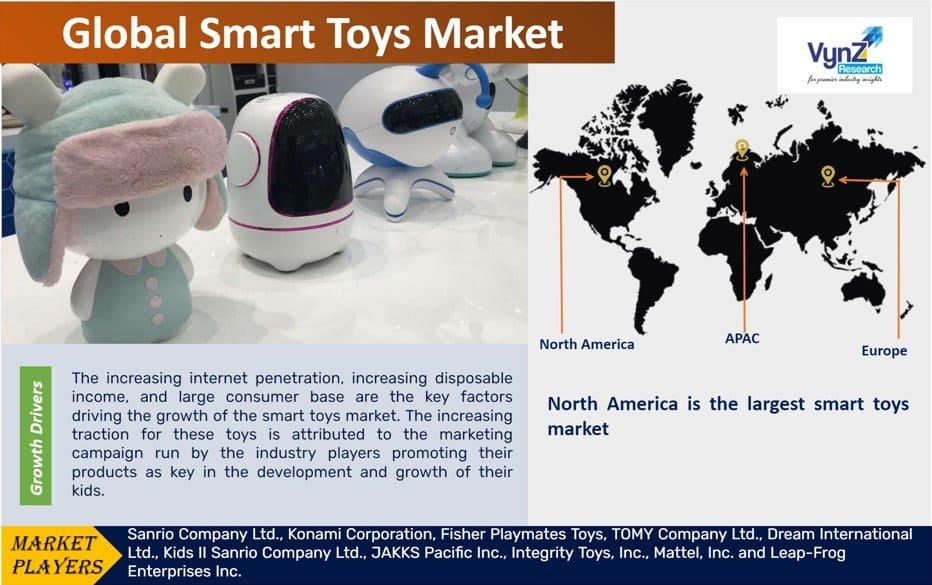| Status : Upcoming | Report Code : VRICT5106 | Industry : ICT & Media | Available Format :

|

Global Smart Toys Market – Analysis and Forecast (2025 – 2030)
Industry Insights by Technology (Bluetooth, Wi-Fi, RFID, NFC), by Type (App-Enabled Mechanical Toys, Health-Tracking Toys or Wearable, Voice or Image Recognition Toys, Screenless Toys, Puzzles and Building Games, Toys-to-Life, Others), by Distribution Channel (Offline Stores, Toy Shops, Specialty Stores, Online Stores, Others) and by Geography (North America, Europe, Asia-Pacific, Middle East and Rest of the World)
Industry Overview
The Global Smart Toys Market is expected to grow at a steady CAGR of around 15.4% and reach a total market value of USD 37.1 billion by the end of 2030 during the forecast period. The primary causes of such significant growth in the global smart toys market include a growing population, higher disposable income, and rising internet penetration. Technological developments that make the smart toys of today more interactive and intelligent will also contribute fairly to the growth.
Apart from that the manufacturers of these toys have come up with several new products that are not only popular among the kids for playing but are also very useful in learning and developing new skills. All these attributes help in creating a greater utility and acceptance of these toys both among the kids and their parents as well. Another significant factor that helps the global smart toys market to grow is the rise in the number of working parents. These toys help them keep their kids engaged in more meaningful activities while they carry on with their respective jobs.
Furthermore, the growing adoption of network-connected and IoT devices is also supposed to influence the growth of the global smart toys market just as the rising popularity of STEM (Science, Technology, Engineering, and Math) education is. These toys can help children learn complex things in an interactive and fun way. These toys can even teach about electronics, coding, and robotics.
As a consequence of these useful attributes, these toys are gaining more traction among users and in the market. Both of these are expected to grow significantly during the forecast period.

Smart Toys Market Segmentation
Insight by Technology
According to the technology used in these toys, the global smart toys market can be divided into wi-fi, Bluetooth, NFC, and RFID categories.
Among all of them, the RFID category is expected to grow at a much faster rate than the others during the forecast period. This is mainly due to the higher adoption of this technology and its use for tagging and tracking products. It also helps in providing a much better customer experience since it stores data in a memory chip using a specific antenna.
Insight by Type
There are different types of smart toys available in the market and based on these types, the global smart toys market can be divided into health-tracking toys, wearable toys, app-enabled mechanical toys, screenless toys, puzzles, voice recognition or image recognition toys, toys-to-life, building games, and more.
Out of these smart toys, voice or image recognition toys will grow at a faster rate during the forecast period. This is mainly due to the growing adoption of Artificial Intelligence in several developed and developing countries.
Insight by Distribution Channel
According to the distribution channel, the global smart toys market is divided into offline stores, online stores, specialty stores, toy shops, and others. Among all these distribution channels, the toy shops category will grow at a larger scale in comparison to others in the forecast period. However, in terms of growth rate, it will be the fastest for the online stores segment for the same period. This is mainly due to the increasing penetration of eCommerce and awareness among consumers about online stores.
Global Smart Toys Market Report Coverage
|
Report Metric |
Details |
|
Historical Period |
2018 - 2023 |
|
Base Year Considered |
2024 |
|
Forecast Period |
2025 - 2030 |
|
Market Size in 2024 |
U.S.D. XX Billion |
|
Revenue Forecast in 2030 |
U.S.D. 37.1 Billion |
|
Growth Rate |
15.4% |
|
Segments Covered in the Report |
By Technology, By Type, and By Distribution Channel |
|
Report Scope |
Market Trends, Drivers, and Restraints; Revenue Estimation and Forecast; Segmentation Analysis; Impact of COVID-19; Companies’ Strategic Developments; Market Share Analysis of Key Players; Company Profiling |
|
Regions Covered in the Report |
North America, Europe, Asia-Pacific, Middle East, and Rest of the World |
Industry Dynamics
Industry Trends
In the past few years, the major players in the industry have invested a lot of money to research and develop new technologies and activities to come up with better and more attractive products. Technological advancements and implementations such as AI and machine learning in the new products by the market players are a noticeable trend.
This has led to the launch of a wide variety of new interactive products by different established and startup technological companies, such as robots, coding toys, VR headsets, app-connected toys, smart building blocks, and puzzles.
There is also a significant surge in the use of these smart devices in the coaching centers, hotel, and tourism industries. The main objective behind it is to attract new customers and enhance the market base.
These toys are also used extensively in homes for cognitive development, learning educative content, developing problem-solving skills, honing creative skills, personalized learning, and more.
Smart Toys Market Growth Drivers
The growth factors of the global smart toys market are varied and include higher disposable income and internet penetration in developing regions. The growing population also provides manufacturing companies with a large database to cater to, which also influences growth.
The manufacturers of these smart toys also run aggressive promotional promotions, which is the key to the growth of this global smart toy market, influencing the minds of the kids more. This facilitates the adoption of these toys among kids and parents alike to enhance their skills and knowledge along with providing significant health benefits. The rise in the use of tablets, smartphones, and other network-connected devices has also created a favorable platform for smart toys to perform better. Users can connect these toys with different online platforms, mobile apps, and several digital interfaces making the best use of better internet connectivity, interactivity, and content updates. The functionalities and features of these toys promote learning and skill development creating a higher demand in children for these educational toys. These toys are also safe and convenient to use with useful features such as remote control and monitoring abilities.
Apart from educational usefulness, these toys are also good for immersive and interactive playing experiences due to advanced technologies such as AI, VR, and AR. Children can enjoy playing games through voice commands, touch, and gestures. This makes them more dynamic and engaging to play games. These smart toys also work as assistants for children by waking them up in the morning, reminding them of their pending assignments, answering all their questions, and indicating their time to go to bed. Every activity is recorded and visible on the dashboard online to help parents track the activities of their children.
All these features and benefits lead to growth in the global smart toys market during the forecast period.
Smart Toys Market Challenges
The concerns for safety, security and privacy , and cost of these smart toys may hinder the growth of the global smart toys market. The use of AI may result in the loss of confidential and personal data and records to malicious actors. However, manufacturers are continually researching to find new ways to handle such issues and are expected to come up with more effective solutions soon. This will create more opportunities for the global smart toys market during the forecast period.
Smart Toys Market Industry Ecosystem
The major players in the toy industry are developing innovative solutions to leverage the global smart toys market growth. The productivity of these smart toys is improving due to these innovations, which include artificial assistance, the use of AI in entertainment, and more.
Smart Toys Market Geographic Overview
North America is the largest contributor to the global smart toys market. This is because people usually have a higher disposable income and there is a huge amount invested in technological developments, which increases the functionality and adoption of these toys.
In the US, a lot of development is made in the field of AI and it is implemented in these smart toys that have enhanced their utility, which has further enhanced the sales and revenue.
The growth of the global smart toys market will however be fastest in the Asia-Pacific region during the forecast period due to the large customer base, higher disposable income, and integration of AI in the toys to make them more useful. All these factors have encouraged the industry players to invest in the production of smart toys. Also, the governments of these countries have made several amendments to the norms to ensure the privacy and security of the users.
Smart Toys Market Competitive Insight
Key players in the smart toys industry are investing heavily in research and development to improve the quality of the product and are also adopting the latest technologies which are strengthening their position in the market. Moreover, it has been observed that local players are depending upon new technology to develop cost efficiencies in their business operations thus increasing the rivalry in the market to some extent.
Some major players in the smart toys market include Sanrio Company Ltd., Konami Corporation, Fisher Playmates Toys, TOMY Company Ltd., Dream International Ltd., Kids II Sanrio Company Ltd., JAKKS Pacific Inc., Integrity Toys, Inc., Mattel, Inc. and Leap-Frog Enterprises Inc.
Recent Developments by Key Players
LeapFrog Enterprises, Inc. (a leader in innovative educational toys for children) has added new additions to its award-winning infant and preschool lines. These deliciously entertaining food role-play toys include the Build-a-Slice Pizza Cart™, Match & Learn Cookies™, Rainbow Tea for Two™ and Rainbow Learning Lights Mixer™.
JAKKS Pacific, Inc.(a world-leading toy and consumer products manufacturer) collaborated with Authentic Brands Group (Authentic) - a global brand development, marketing and entertainment platform. Through the agreement, JAKKS Pacific will design, manufacture and distribute an extensive range of innovative products inspired by Authentic’s portfolio of iconic brands.
Frequently Asked Questions
Purchase Options
Latest Report
Research Methodology
- Desk Research / Pilot Interviews
- Build Market Size Model
- Research and Analysis
- Final Deliverabvle
Connect With Our Sales Team
- Toll-Free: 1 888 253 3960
- Phone: +91 9960 288 381
- Email: enquiry@vynzresearch.com
Smart Toys Market
